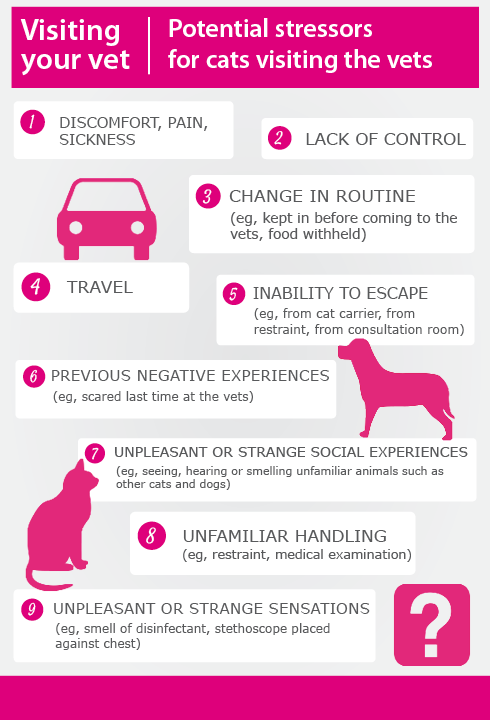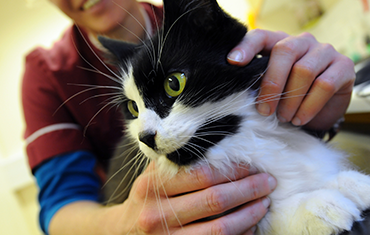All cats should have at least an annual veterinary check, but some will require more frequent visits, and most are likely to need at least one operation during their lives. For many cats, a veterinary visit is a stressful experience. However, there is much we can do to reduce this stress.
By nature, cats are independent, territorial, need to be in control of their surroundings, and sensitive to different smells – all these things make veterinary visits stressful, for both you and your cat.

However, there are simple things that can make a big difference:
Transporting your cat to the clinic
Make sure you use a good cat carrier:
See ‘Putting your cat in a cat carrier‘, ‘Travelling with your cat‘ and ‘Encouraging your cat to be happy in a cat carrier‘
- Never travel with the cat loose in the car – always use a robust carrier.
- Choose carefully – cardboard, for example, is no match for a determined cat!
- The carrier should be easy to clean (preferably plastic or plastic-coated).
- The carrier should not be so large that the cat can fall about in it.
- A carrier that opens at the top is much easier to use as the cat can be gently lifted in or out.
- Cover the carrier with a cloth or towel during the journey to keep the cat calm.
- Secure the carrier in the car in a footwell or on a seat (with a seatbelt) so it cannot move.
- Place the carrier on a towel/padding to keep it level in the car and to absorb any ‘accidents’.
- Drive carefully and gently to avoid the cat being thrown around.
- Stay calm so the cat doesn’t pick up stress from you. Be reassuring and avoid loud noises.
- On arrival at the clinic, avoid rushing. Keep your cat in the carrier and hold it carefully – avoid swinging the carrier or banging it against objects or your legs.
Make sure there are familiar smells for the cat – use some or all of these tips:
- The cat will be less alarmed if the carrier smells familiar and reassuring.
- Ideally, the carrier should be ‘part of the furniture’ and somewhere the cat chooses to sleep or is fed, so it does not only appear when a visit to the vet is imminent!
- Put bedding in the carrier that the cat normally sleeps on or curls up on at home.
- Also, place an article of clothing belonging to the cat’s favourite person in the carrier.
- Wipe a soft cloth around the cat’s face to pick up its scent and rub this around the carrier, especially in the corners, and then leave it in the basket.
- Spray the carrier with Feliway® (a calming synthetic cat scent or pheromone, which may be available from your vet), at least 15 minutes before putting your cat in it.
- If your cat panics at the sight of the carrier, keep calm. Keep the basket close, but out of sight. Wrap the cat in a thick towel/blanket that smells familiar. Put the cat and the towel into the carrier quickly but gently. A top-opening carrier makes this much easier.
- Take some spare bedding (smelling of home) in case the cat is sick or soils the carrier.
In the waiting room
No two clinics are alike and will have different space and organisation. Check with reception staff first if there is an area reserved for cats before bringing your cat in from the car. Ideally look for an accredited Cat Friendly Clinic, but always look for a clinic that separates dogs and cats:
- Look for a completely separate room, or a separated area within the waiting room, for cats.
- Different consulting times for cats.
- Shelves or raised areas where the cat carrier can be placed above floor level while waiting.
- Choose a quiet location and keep the cat carrier covered to avoid visual contact with others.
- If your cat becomes very stressed, perhaps keep it in the car until you are seen by the vet.
- Talking in a quiet voice and with a reassuring tone.
In the consulting room
Look for a clinic and for staff that are quiet, gentle and respectful when handling your cat:
- An accredited Cat Friendly Clinic has promised to make sure all staff treat cats gently, respectfully and with professional skill.
- Cats usually need time to get used to the clinic and to calm down – this should not be a problem and staff should take the time needed.
- If your cat needs holding, the vet should ask a nurse or assistant, so you need not worry.
- If you don’t understand what the vet tells you, ask for further explanation.
- If you are unsure about administering medications, ask a vet, nurse or assistant to give you a demonstration and talk to you. See how to give your cat a tablet
Staying at the clinic
From time to time your cat may need to stay in the clinic, for various reasons. Again, an accredited Cat Friendly Clinic has promised to meet certain standards and you should not be afraid to ask to see where your cat will be staying. Look out for:
- A separate, calm, quiet cat ward; or a separate area within the hospitalisation ward for cats.
- Solid, clean and secure cages that are of adequate size.
- Provision of comfortable bedding and bedding or boxes to allow cats to hide.
- Clinics that allow you to leave bedding from home for the cat to use, that smells of home.
- If your cat is being kept in the clinic for a period, ask when you will be able to visit.
Taking your cat back home after a visit to the vet
Going home
When your cat goes back home after a stay at the veterinary clinic:
- If it has had an anaesthetic that day, your cat may still be subdued and unsteady on its feet.
- Cats may be nervous and disorientated on returning home – talk to them and stroke or groom them gently, allowing them to initiate closer contact whenever they are ready, and use the synthetic cat pheromone Feliway® to add reassurance and security to the home.
- Try to prevent your cat from licking any wound or pulling any stitches present. If this happens, contact the clinic and ask about a special soft collar for your cat to wear temporarily.
- Call the clinic if you have any concerns such as the wound looking red, swollen or discharging; or if you feel that your cat is not recovering well.
- Make sure any medication is given as instructed, and the full course is completed.
- Pain can be difficult to recognise in cats. Signs include loss of appetite, hiding or being withdrawn. If you have any cause for concern, contact the clinic for advice.
- You will probably be advised to keep your cat indoors, at least for the night when it returns home, but possibly for longer, depending on the operation or treatment.
- Provide a quiet, warm spot in the house for your cat to convalesce – with food, water and a litter tray (keeping the tray away from the food).
Re-introduction to other cats at home
Your cat will have picked up unfamiliar scents whilst at the clinic. This may be more pronounced if there has been an overnight or longer stay. These smells may provoke anxiety to any other cats in the home because they smell aversive and/or because they mask the cat’s natural scent thus making identification of the cat difficult. It is best to reintroduce the returning cat gently:
- Do not overwhelm the returning cat with attention from humans, other cats, or dogs.
- Keep your cats in separate rooms for a few hours, or for a day or two and allow some gradual supervised contact. This is recommended because some cats experience temporary behavioural changes after anaesthesia which could be perceived negatively by other cats in the household. It also gives the returning cat the time to smell familiar again through grooming itself and interacting within the home.
- Wash any bedding from your cat’s carrier once you return home, as this will remove any smells of the veterinary clinic.
- Offer bedding from shared resting areas to the returning cat in its separate room. This will help re-establish a familiar smell. If the cats in the household do not usually share their bedding, only offer the returning cat its own bedding to use. Newly washed bedding should only be provided once the returning cat has been reintroduced to the resident cat after the recommended separation time.
- Make sure you are present to assess the response when the cats are re-introduced.
- Spray the areas of your home where the cats spend most of their time with the synthetic cat pheromone (scent) Feliway® Classic if this is available.
Thank you for visiting our website, we hope you have found our information useful.
All our advice is freely accessible to everyone, wherever you are in the world. However, as a charity, we need your support to enable us to keep delivering high quality and up to date information for everyone. Please consider making a contribution, big or small, to keep our content free, accurate and relevant.
Support International Cat Care from as little £3
Thank you.
Donate Now


